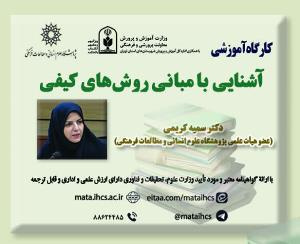شناسایی و اولویت بندی مولفه های حضورگرایی کارکنان در آستان قدس رضوی با رویکرد فراترکیب و دلفی فازی (مقاله علمی وزارت علوم)
درجه علمی: نشریه علمی (وزارت علوم)
آرشیو
چکیده
منابع انسانی در هر سازمانی مهمترین سرمایه آن محسوب می شوند. در آستان قدس رضوی که هدف اصلی آن خدمت به زائرین بارگاه امام رضا (ع) است، این سرمایه از اهمیتی دوچندان برخوردار است. یکی از پدیده های نوظهور که سلامت کارکنان و به تبع آن خدمت رسانی آنها را با مخاطره مواجه می سازد، رفتار حضورگرایی است. این رفتار زمانی بروز می کند که کارمند تصمیم می گیرد با شرایط بیماری و ضعف سلامت در محل خدمت حاضر شود. در این پژوهش که از نظر هدف، کاربردی و به روش کیفی انجام شده است، در ابتدا با روش فراترکیب و تحلیل محتوا کلیه مولفه های محرک حضورگرایی شناسایی و سپس با روش دلفی فازی و اخذ نظرات خبرگان منابع انسانی آستان قدس رضوی، مهم ترین مولفه ها انتخاب و رتبه بندی شد. نتایج نشان داد که مهم ترین عوامل موثر بر حضورگرایی کارکنان در آستان قدس رضوی را می توان در قالب 3 بعد، 13 مقوله محوری و 44 مولفه طبقه بندی کرد. این مقوله های محوری در بعد رفتاری شامل فرهنگ سازمانی، وضعیت سلامت فرد، نگرش و ادراک کارمند درباره پیامدهای غیبت یا حضورگرایی، ارتباطات و تعاملات سازمانی، ویژگی های فردی، شخصیت فرد، نگرش های شغلی و سازمانی، در بعد ساختاری شامل ویژگی ها و رویه های سازمانی، ویژگی های شغل، مدیریت منابع انسانی سازمان و در بعد زمینه ای شامل عوامل فرهنگی و اجتماعی، عوامل اقتصادی جامعه و قانون گذاری و زیرساخت است.Identifying and Prioritizing the Components of Employee Attendanceism at Āstān Quds Razavi with a Meta-Composite and Fuzzy Delphi Approach
Human resources are considered the most important capital in any organization. In Āstān Quds Razavi, whose main purpose is to serve the pilgrims of the court of Ali ibn Musa al- Riḍā (as), this capital has a double importance. One of the emerging phenomena that endangers the health of employees and as a result, their service, is attendanceism. This behavior occurs when the employee decides to come to work with illness and poor health. In this research, which is practical in terms of purpose and conducted in a qualitative method, first, all the driving components of attendanceism were identified with the method of meta-composition and content analysis, and then, using the fuzzy Delphi method and receiving the opinions of Āstān Quds Razavi human resources experts, the most important components were selected and ranked. The results showed that the most important factors affecting the attendanceism of employees in Āstān Quds Razavi can be classified in the form of 3 dimensions, 13 core categories and 44 components. These core categories in the behavioral dimension include organizational culture, individual health status, employee's attitude and perception about the consequences of absenteeism or presenteeism, organizational communication and interactions, individual characteristics, individual personality, occupational and organizational attitudes; and in the structural dimension, it includes organizational characteristics and procedures, job characteristics, human resources management of the organization, and in the contextual dimension, it includes cultural and social factors, economic factors of society, legislation and infrastructure.







